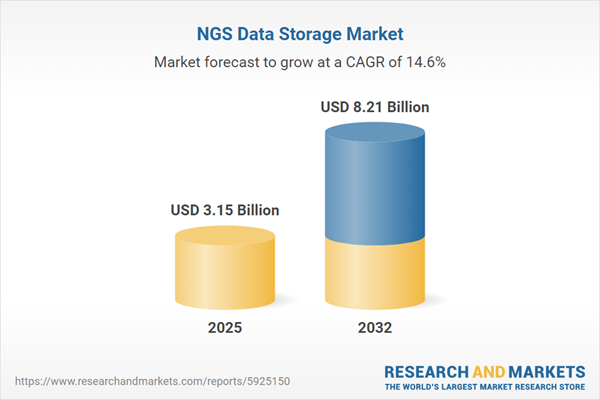Speak directly to the analyst to clarify any post sales queries you may have.
The Next Generation Sequencing (NGS) Data Storage Market is undergoing rapid transformation as organizations across research, clinical, and industrial domains navigate unprecedented data growth, regulatory complexity, and technological innovation. Senior decision-makers face an evolving landscape where robust strategies for managing, securing, and optimizing genomic data are critical for long-term success.
Market Snapshot: NGS Data Storage Market Growth Analysis
The NGS Data Storage Market grew from USD 2.75 billion in 2024 to USD 3.15 billion in 2025. It is expected to continue growing at a CAGR of 14.62%, reaching USD 8.21 billion by 2032.
Scope & Segmentation: Comprehensive Overview of the NGS Data Storage Market
This in-depth market research report delivers actionable intelligence across the critical segments, regions, and technologies shaping NGS data storage strategies and investments.
- Storage Type: Hardware, Services (including Consulting, Integration, Support and Maintenance), Software (Data Compression, Data Management, Data Security)
- Deployment Mode: Cloud (Private Cloud, Public Cloud), Hybrid, On Premises
- End Users: Academic and Research Institutes (Government Labs, Universities), Healthcare Providers (Clinics, Hospitals), Pharmaceutical and Biotechnology Companies (Biotech SMEs, Large Pharma)
- Sequencing Platforms: Long Read Sequencing (Oxford Nanopore, PacBio), Short Read Sequencing (Illumina, MGI)
- Data Type: Archived Data (Cold Storage, Tape), Processed Data (BAM, VCF), Raw Data (BCL, FASTQ)
- Regions Covered: Americas (United States, Canada, Mexico, Brazil, Argentina, Chile, Colombia, Peru), Europe/Middle East/Africa (UK, Germany, France, Russia, Italy, Spain, Netherlands, Sweden, Poland, Switzerland, UAE, Saudi Arabia, Qatar, Turkey, Israel, South Africa, Nigeria, Egypt, Kenya), Asia-Pacific (China, India, Japan, Australia, South Korea, Indonesia, Thailand, Malaysia, Singapore, Taiwan)
- Key Companies: Amazon Web Services, Microsoft Corporation, Alphabet Inc., IBM, Dell Technologies, NetApp, Pure Storage, Oracle, and Quantum Corporation
Key Takeaways: Strategic Insights for Senior Leaders
- Transitioning from traditional on-premises infrastructures to hybrid or cloud environments has become pivotal for organizations aiming to streamline NGS data workflows, balance performance, and enable collaborative research.
- The increasing volume and complexity of sequencing data necessitate flexible architectures that prioritize interoperability, advanced data compression, and automated tiering for operational resilience.
- Heightened focus on data privacy and zero-trust security pushes the integration of robust encryption, identity management, and compliance controls across all storage platforms and workflows.
- Artificial intelligence and machine learning are now enhancing storage ecosystems, enabling predictive maintenance, automated metadata indexing, and faster variant analysis.
- Segment-specific approaches are most effective: academic researchers seek integration with grant-funded projects and open standards, healthcare providers require secure solutions aligned with clinical governance, while biotech and pharma balance data scalability with regulatory adherence.
Tariff Impact: Navigating Supply Chain Shifts
- Recent U.S. tariff adjustments have increased capital expenditure on storage hardware and networking, leading to a round of procurement strategy reassessment, where domestic sourcing and dual-vendor partnerships are considered key risk-mitigation tactics.
- To manage cost volatility, NGS organizations are deploying modular hardware and adopting open-source software, while service providers are restructuring contracts to offset the impact of import duties on ongoing operations.
Methodology & Data Sources
This research combines primary interviews with NGS industry experts and leading decision-makers, detailed secondary analysis of market literature, regulatory documentation, and technical case studies. Rigorous data triangulation and expert panel validation strengthen the reliability and operational relevance of the findings.
Why This Report Matters
- Enables strategic planning and competitive benchmarking by mapping emerging trends, technology priorities, and segment requirements in the NGS data storage market.
- Supports informed investment and procurement decisions by detailing the operational and regulatory implications of deployment choices, regional dynamics, and evolving tariff policies.
- Delivers actionable guidance for risk mitigation, scalability, and regulatory compliance, enhancing research continuity in a rapidly changing environment.
Conclusion
The NGS Data Storage Market is defined by continuous evolution in technology, regulation, and user requirements. Effective alignment of infrastructure, security, and strategy is essential for maximizing research value and enabling future-ready genomic insights.
Additional Product Information:
- Purchase of this report includes 1 year online access with quarterly updates.
- This report can be updated on request. Please contact our Customer Experience team using the Ask a Question widget on our website.
Table of Contents
3. Executive Summary
4. Market Overview
7. Cumulative Impact of Artificial Intelligence 2025
Companies Mentioned
The companies profiled in this NGS Data Storage market report include:- Amazon Web Services, Inc.
- Microsoft Corporation
- Alphabet Inc.
- International Business Machines Corporation
- Dell Technologies Inc.
- NetApp, Inc.
- Pure Storage, Inc.
- Oracle Corporation
- Quantum Corporation
Table Information
| Report Attribute | Details |
|---|---|
| No. of Pages | 183 |
| Published | November 2025 |
| Forecast Period | 2025 - 2032 |
| Estimated Market Value ( USD | $ 3.15 Billion |
| Forecasted Market Value ( USD | $ 8.21 Billion |
| Compound Annual Growth Rate | 14.6% |
| Regions Covered | Global |
| No. of Companies Mentioned | 10 |









